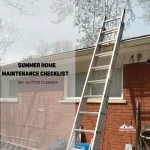Foundation cracks pose significant concerns for homeowners, directly impacting the structural integrity and safety of a home.
These cracks can arise from a variety of causes, each linked to the broader theme of home maintenance.
Understanding these causes empowers homeowners to take preventative measures, ensuring the longevity of their property.
Among the primary causes, soil dynamics play a crucial role. Soil expansion and contraction due to moisture changes can exert pressure on foundation walls.
Additionally, improper drainage contributes to foundation issues, highlighting the importance of maintaining gutters and downspouts.
Overlooking these aspects can lead to water pooling around the foundation, further exacerbating crack formation.
Furthermore, construction quality and the aging process of materials can introduce vulnerabilities, underscoring the need for vigilant home upkeep.
Addressing these causes not only prevents property damage but also safeguards against potential safety hazards, aligning with the search intent of gaining knowledge to mitigate the risk of foundation cracks.
What Are Foundation Cracks?
Foundation cracks are breaks or fissures in the concrete or masonry that make up a home’s foundation. They can range from hairline fractures to wide gaps and signal potential issues with the structural integrity of the building. Identifying the cause of these cracks is essential for maintaining a safe and stable home environment. Foundation cracks can result from natural settling, water damage, soil pressure, and poor construction techniques.
Table of Contents:
- What Are Foundation Cracks?
- How to Identify Foundation Cracks?
- Primary Causes of Foundation Cracks
- Role of Water in Foundation Damage
- Preventive Measures for Foundation Cracks
- Repair Solutions for Foundation Cracks
- Long-Term Impacts of Ignoring Foundation Cracks
- FAQs: Addressing Common Concerns About Foundation Cracks
How Do Foundation Cracks Affect Home Safety?
Foundation cracks directly impact home safety by compromising the structural integrity of a building. Minor cracks may not pose immediate risks but can evolve into significant gaps that threaten the building’s stability. These fissures allow moisture to penetrate, fostering mold growth and weakening structural components, which could lead to costly repairs and potentially hazardous living conditions.
Different Types of Foundation Cracks
Foundation cracks vary based on their direction, width, and location. Vertical and diagonal cracks often result from settling and are usually easier to repair. Horizontal cracks, however, can indicate serious structural threats, often caused by hydrostatic pressure from water accumulation around the foundation. Identifying the type of crack is crucial for determining the appropriate repair method.
How to Identify Foundation Cracks?
Identifying foundation cracks involves regular inspection and recognition of signs that indicate different levels of severity. Homeowners should look for visible cracks in the foundation walls, uneven floors, doors that won’t close properly, and gaps around window frames. Early detection plays a critical role in preventing minor cracks from developing into major structural issues.
Signs of Minor vs. Major Foundation Cracks
Minor foundation cracks are typically hairline, less than 1/4 inch wide, and do not increase in size over time. They often result from natural settling and may not require immediate action. Major cracks, wider than 1/4 inch, growing, or accompanied by other signs of foundation failure, such as sticking doors or sloping floors, indicate serious structural concerns and necessitate professional evaluation.
When to Seek Professional Evaluation
Professional evaluation is advised when homeowners notice major cracks, signs of water damage, or when cracks widen or multiply over time. A foundation specialist can assess the severity of the situation, identify the underlying cause, and recommend appropriate repair solutions. Delaying professional assessment can lead to increased damage and higher repair costs.
Primary Causes of Foundation Cracks
Foundation cracks emerge from a variety of sources, each contributing to the degradation of a home’s structural integrity. Understanding these causes allows homeowners to implement preventative strategies, safeguarding their property.
Soil Shrinkage, Settlement, and Expansion
Soil conditions significantly influence foundation health. Shrinkage and expansion due to moisture changes can cause movement beneath the foundation, leading to cracks. Settlement, the process of the soil compressing under weight over time, also contributes to foundation instability.
Excessive Moisture and Water Damage
Water is a primary factor in foundation damage. Excessive moisture from rain, flooding, or poor drainage softens the soil, causing it to expand and exert pressure on the foundation walls. This can lead to cracking and structural damage.
Poor Construction Practices and Materials
The quality of construction materials and practices plays a critical role in foundation integrity.
Inadequate compaction of the soil beneath the foundation, use of substandard materials, and improper curing of concrete can all lead to the development of cracks.
Earthquakes, Floods, and Natural Disasters
Natural disasters such as earthquakes and floods can cause immediate and severe foundation cracks. These events can shift the ground, apply unusual pressure, and lead to significant structural damage.
Role of Water in Foundation Damage
Water’s impact on foundations cannot be overstated, as it directly influences the likelihood and severity of cracking through various mechanisms.
How Overwatering Your Garden Affects Foundations
Consistent overwatering in garden areas adjacent to a home can saturate the soil, leading to expansion and increased pressure on foundation walls. This often results in the formation of cracks, especially if the soil lacks proper drainage.
Overflowing Gutters: A Hidden Culprit
Gutters play a pivotal role in directing water away from the foundation. When they overflow, water pools around the base of the home, softening the soil and increasing the risk of foundation cracks. Regular maintenance of gutters and downspouts is essential to prevent this issue.
Preventing Gutter Overflow to Protect Your Foundation
Preventive measures include cleaning gutters regularly, ensuring downspouts direct water away from the foundation, and installing gutter guards to prevent blockages. These steps can significantly reduce the risk of foundation damage caused by water.
Improper Drainage Systems and Their Impact
An effective drainage system is crucial for foundation health. Poorly designed or clogged drainage can lead to water accumulation around the foundation, exacerbating soil expansion and contraction cycles that contribute to cracking. Implementing proper drainage solutions mitigates this risk, protecting the foundation from water-induced stress.
Preventive Measures for Foundation Cracks
Preventing foundation cracks is pivotal in maintaining a home’s structural integrity and safety. Adopting proactive measures can significantly reduce the risk of foundation damage, protecting homeowners from potential costly repairs.
Importance of Proper Land Grading
Proper land grading ensures water flows away from the home’s foundation, preventing soil saturation and the subsequent pressure that can cause cracks. A slope of at least 6 inches over 10 feet is recommended to facilitate effective drainage.
Regular Maintenance of Gutters and Downspouts
Gutters and downspouts play a critical role in directing water away from the foundation. Ensuring they are clean and free from blockages prevents overflow and pooling around the base of the home, mitigating the risk of water-induced foundation cracks.
Choosing the Right Soil and Landscaping Techniques
The type of soil and landscaping techniques used around a home can influence foundation health. Soils that drain well reduce the likelihood of expansion and contraction that can lead to cracking. Additionally, positioning plants and trees at appropriate distances ensures roots do not grow into the foundation, causing damage.
Repair Solutions for Foundation Cracks
Once foundation cracks are identified, selecting the right repair method is crucial to restoring structural integrity. The approach depends on the crack’s severity and the underlying cause.
DIY Fixes vs. Professional Repairs: What You Need to Know
For minor cracks, DIY repair kits may provide a temporary solution. However, professional repairs are necessary for cracks indicative of structural issues. Experts can inject epoxy or polyurethane foam for non-structural cracks or undertake underpinning for more serious conditions.
Latest Techniques in Foundation Crack Repair
The field of foundation repair constantly evolves, with new techniques offering better outcomes. Polyurethane injection is effective for waterproofing cracks, while helical piers and hydraulic jacking are used to address underlying soil issues and lift the foundation to its original position. Consulting with a professional ensures the most appropriate, up-to-date method is applied.
Long-Term Impacts of Ignoring Foundation Cracks
Ignoring foundation cracks can have significant long-term consequences, affecting both the safety and financial value of a home. Understanding these impacts is crucial for homeowners to take timely action.
How Foundation Damage Affects Home Value
Foundation damage can drastically reduce a home’s market value. Potential buyers are likely to be deterred by the prospect of undertaking costly repairs, leading to decreased interest or lower offers. A secure and stable foundation, conversely, enhances property value and buyer confidence.
Risks of Mold and Mildew Growth
Moisture infiltration through foundation cracks creates an ideal environment for mold and mildew growth. This not only poses health risks to occupants, especially those with respiratory issues, but can also lead to further structural damage if left unaddressed.
FAQs: Addressing Common Concerns About Foundation Cracks
Addressing common questions can help homeowners understand the importance of proactive foundation maintenance and repair.
Can Small Cracks Become Major Problems?
Yes, small cracks can evolve into major issues if ignored. What begins as a minor aesthetic concern can expand, compromising the structural integrity of the home and leading to significant repair costs.
How Often Should I Inspect My Foundation?
Regular inspections, at least annually, are recommended to identify potential problems early. After extreme weather events or if signs of damage are noticed, additional inspections should be conducted to assess and address any new or worsening issues.


